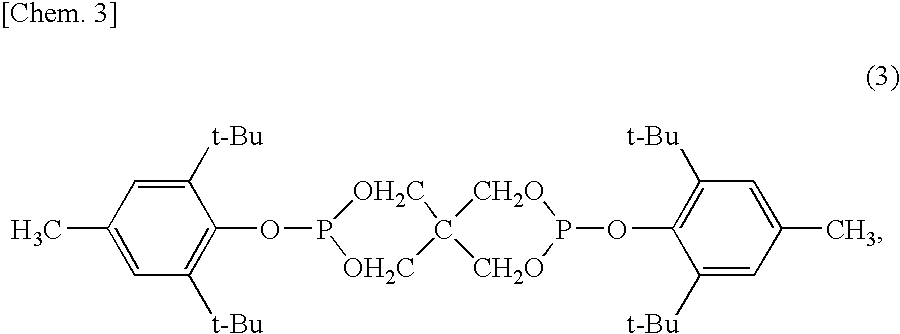Low melt viscosity polyglycolic acid, production process thereof, and use of low melt viscosity polyglycolic acid
a polyglycolic acid, low melt viscosity technology, applied in the direction of organic chemistry, transportation and packaging, group 5/15 element organic compounds, etc., can solve the problems of reducing thickness, miniaturization or weight reduction, and reducing the thickness of synthetic resin molded products, etc., to achieve excellent melt flowability, reduce pressure upon injection molding, and low melt viscosity
- Summary
- Abstract
- Description
- Claims
- Application Information
AI Technical Summary
Benefits of technology
Problems solved by technology
Method used
Image
Examples
example 1
[0096]Pellets of a polyglycolic acid resin composition obtained by adding 0.03 part by weight of a heat stabilizer AX-71 (mono- or di-stearyl acid phosphate; product of ADEKA CORPORATION) to 100 parts by weight of a ring-opening polymer of glycolide were used as a polyglycolic acid in a solid state at ordinary temperature.
[0097]This polyglycolic acid had a melting point Tm of 220° C., a melt viscosity of 1,010 Pa·s as measured at a temperature (Tm+20° C.=240° C.) and a share rate of 122 sec−1, and a water content of 30 ppm. The pellets of the polyglycolic acid were obtained by a process, in which the polyglycolic acid resin composition is melt-extruded into strand from an extruder, and the strand is cooled in water and cut, and had a uniform form of an average particle diameter of 2.8 mm and an average length of 2.7 mm. The temperature at 3%-weight loss on heating of the polyglycolic acid as measured by using the pellets was 352° C.
[0098]Fifty grams of the pellets were placed in a g...
example 2
[0101]The pellets obtained in Example 1 and having the water content of 6,520 ppm were subjected to a drying and heating treatment for 5 hours in an oven at 150° C. in a dry air atmosphere. After 5 hours, the pellets retained their form. The pellets were taken out of the oven to measure a water content. As a result, the water content was 10 ppm. These pellets were used to measure the melt viscosity of the polyglycolic acid at a temperature (Tm+10° C.=230° C.) and a shear rate of 122 sec−1. As a result, the melt viscosity was 46 Pa·s. The same pellets were used to measure the melt viscosity of the polyglycolic acid at a temperature (Tm+20° C.=240° C.) and a shear rate of 122 sec−1. As a result, the melt viscosity was 33 Pa·s. The pellets were used to measure a temperature at 3%-weight loss on heating. As a result, the temperature was 340° C. The results are shown in Table 1.
example 3
[0102]Pellets of a polyglycolic acid resin composition obtained by adding 0.03 part by weight of a heat stabilizer AX-71 (mono- or di-stearyl acid phosphate; product of ADEKA CORPORATION) to 100 parts by weight of a ring-opening polymer of glycolide were used as a polyglycolic acid in a solid state at ordinary temperature.
[0103]This polyglycolic acid had a melting point Tm of 220° C., a melt viscosity of 730 Pa·s as measured at a temperature (Tm+20° C.=240° C.) and a share rate of 122 sec−1, and a water content of 26 ppm. The pellets of the polyglycolic acid were obtained by a process, in which the polyglycolic acid resin composition is melt-extruded into strand from an extruder, and the strand is cooled in water and cut, and had a uniform form of an average particle diameter of 2.2 mm and an average length of 2.5 mm. The temperature at 3%-weight loss on heating of the polyglycolic acid as measured by using the pellets was 350° C.
[0104]Five thousand grams of the pellets were placed ...
PUM
| Property | Measurement | Unit |
|---|---|---|
| melt viscosity | aaaaa | aaaaa |
| temperature | aaaaa | aaaaa |
| temperature | aaaaa | aaaaa |
Abstract
Description
Claims
Application Information
 Login to View More
Login to View More - R&D
- Intellectual Property
- Life Sciences
- Materials
- Tech Scout
- Unparalleled Data Quality
- Higher Quality Content
- 60% Fewer Hallucinations
Browse by: Latest US Patents, China's latest patents, Technical Efficacy Thesaurus, Application Domain, Technology Topic, Popular Technical Reports.
© 2025 PatSnap. All rights reserved.Legal|Privacy policy|Modern Slavery Act Transparency Statement|Sitemap|About US| Contact US: help@patsnap.com



